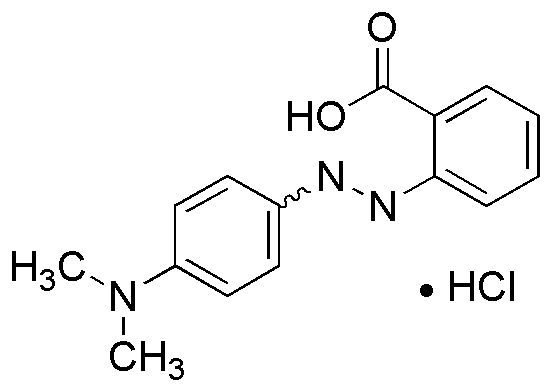Methyl Red hydrochloride is widely utilized in research focused on:
- pH Indicator: It serves as a reliable pH indicator in titrations, changing color from red at pH 4.4 to yellow at pH 6.2, making it invaluable in laboratories for determining acidity levels.
- Biological Studies: Researchers use it to study microbial growth and fermentation processes, as its color change can indicate metabolic activity in various organisms.
- Analytical Chemistry: Methyl Red hydrochloride is employed in the quantitative analysis of certain compounds, providing a straightforward method for determining concentrations in samples.
- Pharmaceutical Applications: It is used in the development of drug formulations, particularly in assessing the stability of active ingredients under different pH conditions.
- Textile Industry: The compound is also utilized as a dye in textiles, offering vibrant colors and good fastness properties, which are essential for high-quality fabric production.
General Information
Properties
Safety and Regulations
Applications
Methyl Red hydrochloride is widely utilized in research focused on:
- pH Indicator: It serves as a reliable pH indicator in titrations, changing color from red at pH 4.4 to yellow at pH 6.2, making it invaluable in laboratories for determining acidity levels.
- Biological Studies: Researchers use it to study microbial growth and fermentation processes, as its color change can indicate metabolic activity in various organisms.
- Analytical Chemistry: Methyl Red hydrochloride is employed in the quantitative analysis of certain compounds, providing a straightforward method for determining concentrations in samples.
- Pharmaceutical Applications: It is used in the development of drug formulations, particularly in assessing the stability of active ingredients under different pH conditions.
- Textile Industry: The compound is also utilized as a dye in textiles, offering vibrant colors and good fastness properties, which are essential for high-quality fabric production.
Documents
Safety Data Sheets (SDS)
The SDS provides comprehensive safety information on handling, storage, and disposal of the product.
Product Specification (PS)
The PS provides a comprehensive breakdown of the product’s properties, including chemical composition, physical state, purity, and storage requirements. It also details acceptable quality ranges and the product's intended applications.
Certificates of Analysis (COA)
Search for Certificates of Analysis (COA) by entering the products Lot Number. Lot and Batch Numbers can be found on a product’s label following the words ‘Lot’ or ‘Batch’.
*Catalog Number
*Lot Number
Certificates Of Origin (COO)
This COO confirms the country where the product was manufactured, and also details the materials and components used in it and whether it is derived from natural, synthetic, or other specific sources. This certificate may be required for customs, trade, and regulatory compliance.
*Catalog Number
*Lot Number
Safety Data Sheets (SDS)
The SDS provides comprehensive safety information on handling, storage, and disposal of the product.
DownloadProduct Specification (PS)
The PS provides a comprehensive breakdown of the product’s properties, including chemical composition, physical state, purity, and storage requirements. It also details acceptable quality ranges and the product's intended applications.
DownloadCertificates of Analysis (COA)
Search for Certificates of Analysis (COA) by entering the products Lot Number. Lot and Batch Numbers can be found on a product’s label following the words ‘Lot’ or ‘Batch’.
*Catalog Number
*Lot Number
Certificates Of Origin (COO)
This COO confirms the country where the product was manufactured, and also details the materials and components used in it and whether it is derived from natural, synthetic, or other specific sources. This certificate may be required for customs, trade, and regulatory compliance.


